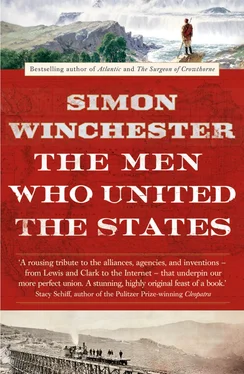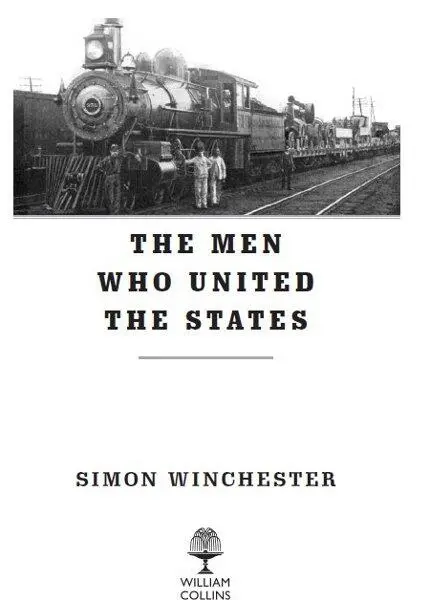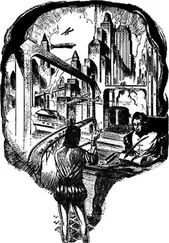Copyright About the Publisher
William Collins
An imprint of HarperCollins Publishers 77–85 Fulham Palace Road, Hammersmith, London W6 8JB
www.harpercollins.co.uk
First published in Great Britain by William Collins in 2013
Copyright © Simon Winchester 2013
Simon Winchester asserts the moral right to be identified as the author of this work.
A catalogue record for this book is available from the British Library.
Original jacket design by Richard Ljoenes. Map courtesy of the Library of Congress. Front cover: (top) The Arrival of Captain Lewis at the Great Falls of Missouri , courtesy of the artist, Charles Fritz; (bottom) Trestle at Promontory , by Andrew J. Russell, from photographs taken during construction of the Union Pacific Railroad, Beinecke Rare Book and Manuscript Library, Yale University.
All rights reserved under International and Pan-American Copyright Conventions. By payment of the required fees, you have been granted the non-exclusive, non-transferable right to access and read the text of this e-book on-screen. No part of this text may be reproduced, transmitted, down-loaded, decompiled, reverse engineered, or stored in or introduced into any information storage and retrieval system, in any form or by any means, whether electronic or mechanical, now known or hereinafter invented, without the express written permission of HarperCollins
Source HB ISBN: 9780007532377
Ebook Edition © September 2013 ISBN: 9780007532384
Version: 2014-06-26
Praise
From the reviews of The Men Who United the States :
‘Simon Winchester is one of the quintessentially English writers who will go anywhere, literally and figuratively … because of his amateur status, boldness and decidedly nonacademic approach to history, [he] achieves something remarkable here’
Literary Review
‘Winchester understands that specificity is what counts, as it always does in writing … He has read prodigiously, and has pounded the trail with equal diligence’
Sunday Telegraph
‘This book’s cleverness lies in an organization neither chronological nor biographical, but elemental: there are five sections on wood, earth, fire, water and metal … This is an imaginative piece of historical writing, interwoven with memoir. But it is, in the end, more than either of those things: it is a love poem to the American landscape and to the spirit of people, now dead, who traversed it’
BBC History
‘Entertaining … A pleasure’
New York Times Book Review
‘Mesmerizing and fascinating … Winchester is a master storyteller, and all the individuals, places, and events that he passionately writes about come to life in exquisite detail … a magnificent achievement in writing, storytelling, and education’
New York Journal of Books
‘The fun here is in Winchester’s exuberant enthusiasm for his new country and for the characters he has found who helped shape it’
Washington Post
‘Vivid, valuable … Winchester’s book is especially fine on retrieving the forgotten map makers, geologists, topographers and engineers who showed them the way … what an extraordinary, propulsive tale he tells’
Wall Street Journal
‘Simon Winchester never disappoints, and The Men Who United the States is a lively and surprising account of how this sprawling piece of geography became a nation. This is America from the ground up. Inspiring and engaging’
Tom Brokaw
‘A very charming and meticulously researched celebration of America’s enduring unity and the various people and historical forces that have made it possible’
The National
‘An elegantly written account … filled with fascinating information’
Boston Globe
‘Another winning book from a historian whose passion for his subjects saturates his works’
Kirkus Reviews
‘Winchester masterfully evokes the excitement of the nation’s early days – when opportunity and possibility were manifest in uncharted mountains and new technologies – while bringing each of his subjects to life … the key to the book’s greatest achievement [is in] conveying the large-scale narrative of unification via the small-scale experience of the individual – the creation of a people by the agglomeration of persons’
Publisher’s Weekly
‘[His] writing style is a fortuitous juxtaposition of the rigors of scientific inquiry with the reporter’s keen eye for a good story. The happy result is this elegantly written and captivating meditation on the unique physiology of that cultural-political phenomenon known as the United States of America’
Washington Times
February 23, 2012, was the eightieth birthday of my mother-in-law,
MRS. AKIKO SATO.
Shortly before the family celebration, I told her of my plan to structure my book around the five so-called classical elements. She briefly left the room, returning with this card on which she had handwritten this aide-mémoire for me, the five elements rendered in English, Chinese characters, and Japanese.
Three hours later, toward the end of her party, happy and surrounded by friends and family, Mrs. Sato collapsed and later died.
This card was thus the very last thing she ever wrote in her life—one ample reason among many for me to offer this book as dedication both to her daughter
SETSUKO
and, with gratitude and respect, to the memory of
MRS. AKIKO SATO.
Born, Tokyo, 1932. Died, New York, 2012.
May this small offering be her memorial.
Think of the United States today—the facts of these thirty-eight or forty empires solder’d in one—sixty or seventy millions of equals, with their lives, their passions, their future—these incalculable, modern, American, seething multitudes around us, of which we are inseparable parts!
—WALT WHITMAN, A Backward Glance o’er Travell’d Roads (PREFACE TO THE 1888 EDITION OF Leaves of Grass )
CONTENTS
Cover
Title Page
Copyright
Praise
Dedication
Epigraph
List of Maps and Illustrations
Author’s Note
Preface: The Pure Physics of Union
PART I: WHEN AMERICA’S STORY WAS DOMINATED BY WOOD, 1785–1805
A View across the Ridge
Drawing a Line in the Sand
Peering through the Trees
The Frontier and the Thesis
The Wood Was Become Grass
Encounters with the Sioux
First Lady of the Plains
High Plains Rafters
Passing the Gateway
Shoreline Passage
PART II: WHEN AMERICA’S STORY WENT BENEATH THE EARTH, 1809–1901
The Lasting Benefit of Harmony
The Science That Changed America
Drawing the Colors of Rocks
The Wellspring of Knowledge
The Tapestry of Underneath
Setting the Lures
Off to See the Elephant
The West, Revealed
The Singular First Adventure of Kapurats
The Men Who Gave Us Yellowstone
Diamonds, Sex, and Race
PART III: WHEN THE AMERICAN STORY TRAVELED BY WATER, 1803–1900
Journeys to the Fall Line
The Streams beyond the Hills
The Pivot and the Feather
Читать дальше













